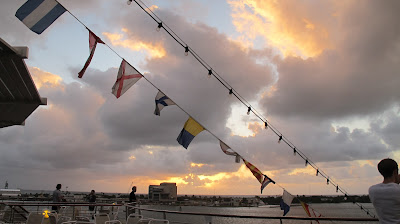Well....we traversed the Panama Canal-- sailing from the Pacific side
for almost nine hours, when we came out on the eastern edge at the
Caribbean Sea, we were, in fact, almost home.
Transiting the Panama Canal during the day the MV Explorer-our ship-
positioned itself in early morning at the first of five locks. It was
predicted to be very hot and humid for the eight hour journey and
possibly interrupted with showers and, in fact, it was just that.
Luckily we are all still taking our malaria pills and have had the
yellow fever vaccination but these issues were more of a problem for
laborers who from 1904-1914 worked to construct this shipping
conduit--the largest government sponsored construction project in the
world.
The whole canal system is a triumph of genius and blood sweat and tears. Using only gravity, it takes 52 million gallons of fresh water to get a ship raised up and lowered through the 5 lock system. And ships who are positioned to begin the expensive trek---it will cost our ship over $100K to make passage from one ocean to another--- traveling at 2 miles per hour through the system.
Since the early 20th century the Americans have controlled the Canal and Panama. Historians say the US has always considered the Caribbean our lake. Nevertheless, in the 1970s Jimmy Carter decided that Canal should be turned over to Panamanians --- pullout came in 1999 and by 2000 Panama was in full control.
We just finished our transit from one sea to another and it is beautiful here ---a tropical rainforest with Panama City's skyline on the horizon. One of the students from my extended family asked why the Americans made this canal so narrow - imagine what it took to dig mostly by hand this 10 mile ditch--- they are enlarging it as we speak so by 2014 there will be many more ships transiting through the system ----- An amazing experience.
Everyone has been celebrating our voyage and return home. We are almost
there. And it is somewhat bittersweet --Tonight I have a
Christmas/Goodbye party with my ship family and friends. We have made a
bond that is impossible to describe and a cohort of new life long
friends for which we all are so grateful.
 |
| Dining room staff |
 |
| Mandi |
 |
| Perry |
 |
| David Yu |
 |
| My family and Howard |
Our English professor likened this incredible four month voyage to an Alice in Wonderland experience. Alice falls down the hole and finds herself in a completely unknown land--full of mystery and confusion. The Red Queen tells Alice she has to keep running to stay in place. We traveled around the world at about 20 miles per hour. Running often to just stay in the day, sometimes we felt out of control---finding our classes, understanding the new system of keeping track of the weeks--- A and B days not Monday, Tuesday and beyond. And even now we are still on A and B days. So many times we felt in and out of control---sometimes we knew the way -sometimes we were lost. Sometimes we had enuf money, other times we didn't. Sometimes we new the rules, sometimes we didn't have a clue.
 |
| Neptune Day Celebrant |
For the last four months bizarre discovery has been the way of life. And exciting adventures seem to take no time at all.
I will be home the night of the 14th and will look forward to seeing all of you soon! And ....I have taken may pictures and will post them and other log entries when I can get Internet time -- my
blog--susanstjohnatsea@blogger.com
And....... Kepler 22b --- a newly discovered planet has an average temp of 72....Imagine that!























